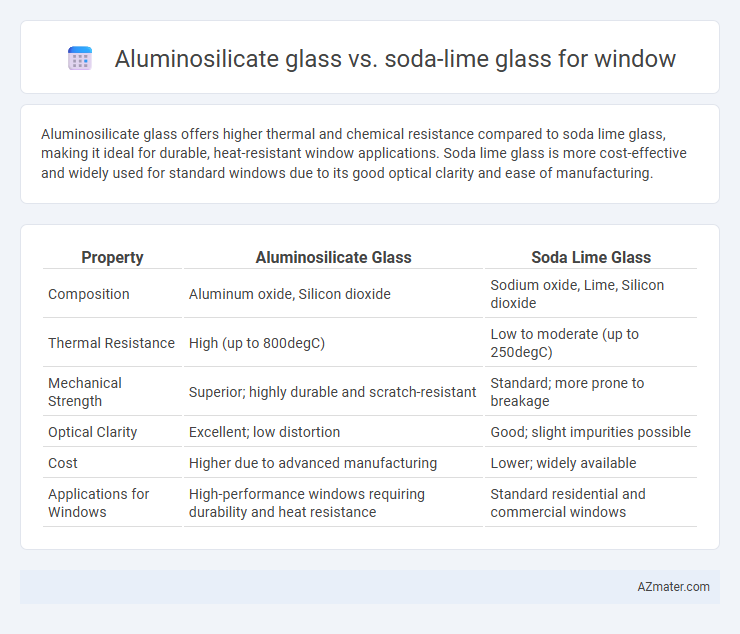Aluminosilicate glass offers higher thermal and chemical resistance compared to soda lime glass, making it ideal for durable, heat-resistant window applications. Soda lime glass is more cost-effective and widely used for standard windows due to its good optical clarity and ease of manufacturing.
Table of Comparison
| Property | Aluminosilicate Glass | Soda Lime Glass |
|---|---|---|
| Composition | Aluminum oxide, Silicon dioxide | Sodium oxide, Lime, Silicon dioxide |
| Thermal Resistance | High (up to 800degC) | Low to moderate (up to 250degC) |
| Mechanical Strength | Superior; highly durable and scratch-resistant | Standard; more prone to breakage |
| Optical Clarity | Excellent; low distortion | Good; slight impurities possible |
| Cost | Higher due to advanced manufacturing | Lower; widely available |
| Applications for Windows | High-performance windows requiring durability and heat resistance | Standard residential and commercial windows |
Introduction to Window Glass Types
Aluminosilicate glass offers superior strength and thermal resistance compared to soda lime glass, making it ideal for high-performance window applications. Soda lime glass, the most common window glass type, provides cost-effective clarity and durability suitable for standard residential and commercial windows. Understanding the distinct properties of aluminosilicate and soda lime glass helps optimize window design for safety, energy efficiency, and longevity.
What is Aluminosilicate Glass?
Aluminosilicate glass is a type of glass composed primarily of aluminum oxide (Al2O3) and silicon dioxide (SiO2), known for its superior strength, thermal resistance, and chemical durability compared to soda lime glass. Commonly used in high-performance applications like smartphone screens and specialized windows, aluminosilicate glass withstands higher temperatures and mechanical stresses, making it ideal for energy-efficient and impact-resistant windows. In contrast, soda lime glass, the most widely used glass in standard windows, offers lower durability and thermal tolerance but remains cost-effective for general use.
What is Soda Lime Glass?
Soda lime glass is the most common type of glass used for windows, composed primarily of silica (SiO2), soda (Na2O), and lime (CaO), which provides a cost-effective and versatile solution with good optical clarity and moderate strength. Compared to aluminosilicate glass, soda lime glass has lower thermal resistance and is more prone to breakage under high impact or temperature fluctuations. Aluminosilicate glass offers enhanced durability, heat resistance, and strength, making it ideal for applications requiring greater performance and longevity.
Chemical Composition Comparison
Aluminosilicate glass contains a higher percentage of aluminum oxide (Al2O3) and silicon dioxide (SiO2) compared to soda lime glass, which mainly consists of silica (SiO2), sodium oxide (Na2O), and calcium oxide (CaO). The increased aluminum oxide in aluminosilicate glass enhances its chemical durability and resistance to heat and thermal shock, making it more suitable for demanding window applications. Soda lime glass, with its lower aluminum content and higher alkali metals, is less chemically stable but is cost-effective and widely used for standard window panes.
Mechanical Strength and Durability
Aluminosilicate glass offers superior mechanical strength and durability compared to soda lime glass, making it highly resistant to impacts and thermal stress. Its enhanced toughness results from a higher alumina content, which improves its resistance to cracks and scratches. Soda lime glass, while more affordable, is more prone to breakage and weathering, limiting its effectiveness for long-lasting window applications.
Thermal and UV Resistance
Aluminosilicate glass offers superior thermal resistance with a high softening point around 1,700degC, making it highly resistant to thermal shock compared to soda lime glass, which softens at approximately 720degC. In terms of UV resistance, aluminosilicate glass exhibits enhanced UV filtering capabilities, effectively blocking harmful ultraviolet rays and preventing UV-induced degradation. Soda lime glass has lower thermal durability and less effective UV protection, making aluminosilicate glass the preferred choice for windows exposed to intense heat and sunlight.
Cost and Availability
Aluminosilicate glass typically costs more than soda-lime glass due to its enhanced durability and higher manufacturing complexities. Soda-lime glass is widely available and the most commonly used glass for windows, benefiting from large-scale production and lower raw material expenses. The higher cost and limited availability of aluminosilicate glass make it a preferred choice only for specialized applications requiring superior strength and thermal resistance.
Applications in Modern Windows
Aluminosilicate glass offers superior strength, thermal resistance, and durability compared to soda lime glass, making it ideal for modern windows in high-rise buildings and energy-efficient homes. Its resistance to thermal shock and scratching enhances safety and longevity in architectural glazing and smart window applications. Soda lime glass remains popular in standard residential windows due to its cost-effectiveness and ease of production but lacks the enhanced performance properties required for advanced building designs.
Sustainability and Environmental Impact
Aluminosilicate glass offers superior durability and scratch resistance compared to soda lime glass, reducing the frequency of replacements and thus minimizing waste generation in window applications. The production of aluminosilicate glass requires less energy due to lower melting temperatures, contributing to a smaller carbon footprint than soda lime glass, which relies on higher-temperature processes. Additionally, aluminosilicate glass's enhanced longevity supports sustainable building practices by extending window lifespan and reducing the environmental impact associated with manufacturing and disposal.
Choosing the Right Glass for Your Windows
Aluminosilicate glass offers superior thermal resistance and durability compared to soda lime glass, making it ideal for windows in harsh environments or areas exposed to rapid temperature changes. Soda lime glass is more cost-effective and widely used for standard window applications but lacks the enhanced strength and chemical stability of aluminosilicate glass. Choosing the right glass depends on prioritizing durability and heat resistance versus budget and conventional performance needs.

Infographic: Aluminosilicate glass vs Soda lime glass for Window
 azmater.com
azmater.com